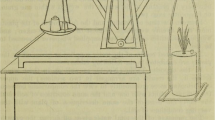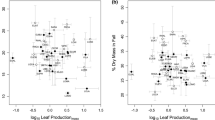Summary
Time-consuming calorimetry is not necessary to determine energy allocation patterns in populations of plants with primarily carbohydrate seed reserves. In four ecologically diverse species there is no significant difference between energy allocation patterns based on calories and on dry weights of plant parts. Significant energy allocation differences among species and among populations of one species are reflected equally well by caloric and dry weight measures.
Similar content being viewed by others

References
Abrahamson, W. G., Gadgil, M.: Growth form and reproductive effort in goldenrods (Solidago, Compositae). Am. Naturalist 107, 651–661 (1973)
Anderson, R. C., Loucks, O. L.: Aspects of the biology of Trientalis borealis Raf. Ecology 54, 798–808 (1973)
Bliss, L. C.: Caloric and lipid content in alpine tundra plants. Ecology 43, 753–757 (1962)
Boyd, C. E.: Amino acid, protein, and caloric content of vascular aquatic macrophytes. Ecology 51, 902–906 (1970)
Gadgil, M. D., Solbrig, O. T.: The concept of r- and K-selection: evidence from wild flowers and some theoretical considerations. Am. Naturalist 106, 14–31 (1972)
Gaines, M. S., Vogt, K. J., Hamrick, J. L., Caldwell, J.: Reproductive strategies and growth patterns in sunflowers (Helianthus). Am. Naturalist 108, 889–894 (1974)
Golley, F. B.: Energy values of ecological materials. Ecology 42, 581–584 (1961)
Golley, F. B.: Caloric value of wet tropical forest vegetation. Ecology 50, 517–519 (1969)
Harper, J. L., Ogden, J.: The reproductive strategy of higher plants. I. The concept of strategy with special reference to Senecio vulgaris L. J. Ecol. 58, 681–698 (1970)
Hickman, J. C.: Environmental unpredictability and plastic energy allocation strategies in the annual Polygonum cascadense (Polygonaceae). J. Ecol. 63 (in press, 1975)
Levin, D. A.: The oil content of seeds: an ecological perspective. Am. Naturalist 108, 193–206 (1974)
Lieth, H.: In: F. Eckardt, ed., Functioning of terrestrial ecosystems at the primary production level, p. 233. Paris: UNESCO 1968
Long, F. L.: Application of calorimetric methods to ecological research. Plant Physiol. 9, 323–337 (1934)
Ogden, J.: The reproductive strategy of higher plants. II. The reproductive strategy of Tussilago farfara L. J. Ecol. 62, 291–324 (1974)
Paine, R. T.: The measurement and application of the calorie to ecological problems. Ann. Rev. Ecol. Syst. 2, 145–164 (1971)
Author information
Authors and Affiliations
Rights and permissions
About this article
Cite this article
Hickman, J.C., Pitelka, L.F. Dry weight indicates energy allocation in ecological strategy analysis of plants. Oecologia 21, 117–121 (1975). https://doi.org/10.1007/BF00345554
Received:
Issue Date:
DOI: https://doi.org/10.1007/BF00345554



